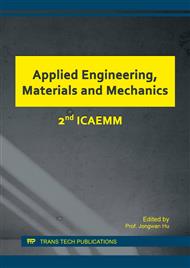[1]
H. M. Wang, Materials' fundamental issues of laser additive manufacturing for high-performance large metallic components. Acta Aeronaut. Astronaut. Sin. 35(10) (2014) 2690-2698.
Google Scholar
[2]
W. D. Huang, X. Lin, Research progress in laser solid forming of high performance Metallic component. Mater. China, 29(6) (2010) 12-27+49.
Google Scholar
[3]
W. Du, et al., A novel method for Additive/Subtractive Hybrid Manufacturing of metallic parts. Proc. Manuf. 5 (2016) 1018-1030.
DOI: 10.1016/j.promfg.2016.08.067
Google Scholar
[4]
G. Strano, et al., Surface roughness analysis, modelling and prediction in selective laser melting. J. Mater. Proc. Tech. 213(4) (2013) 589-597.
Google Scholar
[5]
Y. Y. Sun, et al., The influence of as-built surface conditions on mechanical properties of Ti-6Al-4V additively manufactured by Selective Electron Beam Melting. JOM, 68(3) (2016) 791-798.
DOI: 10.1007/s11837-015-1768-y
Google Scholar
[6]
G. Kasperovich, J. Hausmann, Improvement of fatigue resistance and ductility of Ti-6Al-4V processed by selective laser melting. J. Mater. Proc. Tech. 220 (2015) 202-214.
DOI: 10.1016/j.jmatprotec.2015.01.025
Google Scholar
[7]
C. H. Che-Haron, A. Jawaid, The effect of machining on surface integrity of titanium alloy Ti-6Al-4V. J. Mater. Proc. 166(2) (2005) 188-192.
DOI: 10.1016/j.jmatprotec.2004.08.012
Google Scholar
[8]
S. G. Du, et al, Study on surface morphology and microstructure of titanium alloy TC4 under high speed milling. Acta Aeronaut. Astronaut. Sin. 29(6) (2008) 1710-1715.
Google Scholar
[9]
Z. C. Yang, et al, Effects of high speed milling parameters on surface integrity of titanium alloy TC4. J. Northwestern Polytech. Univ. (04) (2009) 538-543.
Google Scholar
[10]
B. Vrancken, et al., Heat treatment of Ti6Al4V produced by Selective Laser Melting: Microstructure and mechanical properties. J. Alloy. Comp. 541 (2012) 177-185.
DOI: 10.1016/j.jallcom.2012.07.022
Google Scholar
[11]
L. Thijs, et al., A study of the microstructural evolution during selective laser melting of Ti-6Al-4V. Acta Mater. 58(9) (2010) 3303-3312.
DOI: 10.1016/j.actamat.2010.02.004
Google Scholar
[12]
A. Bordin, et al., Comparison between wrought and EBM Ti-6Al-4V machinability characteristics. Key Eng. Mater. 611-612 (2014) 1186-1193.
DOI: 10.4028/www.scientific.net/kem.611-612.1186
Google Scholar
[13]
S. Sartori, et al., Analysis of the surface integrity in cryogenic turning of Ti-6Al-4V produced by Direct Melting Laser Sintering. Proc. CIRP, 45 (2016) 123-126.
DOI: 10.1016/j.procir.2016.02.328
Google Scholar
[14]
A. Bordin, et al., Analysis of tool wear in cryogenic machining of additive manufactured Ti6Al4V alloy. Wear, 328-329 (2015) 89-99.
DOI: 10.1016/j.wear.2015.01.030
Google Scholar
[15]
S. Milton, et al., Influence of Finish Machining on the Surface Integrity of Ti-6Al-4V Produced by Selective Laser Melting. Proc. CIRP, 45 (2016) 127-130.
DOI: 10.1016/j.procir.2016.02.340
Google Scholar
[16]
S. Sartori, et al., The influence of material properties on the tool crater wear when machining Ti-6Al-4V produced by Additive Manufacturing Technologies. Proc. CIRP, 46 (2016) 587-590.
DOI: 10.1016/j.procir.2016.04.032
Google Scholar
[17]
Y. S. Zhang, Research on microstructures and properties of Ti-6Al-4V titanium alloy in Laser Rapid Forming. Northwestern Polytech. Univ. (2006).
Google Scholar
[18]
K. Rekedal, D. Liu, Fatigue life of Selective Laser Melted and Hot Isostatically Pressed Ti-6Al-4V Absent of Surface Machining, REKEDAL, Kevin; LIU, David. Fatigue life of selective laser melted and hot isostatically pressed Ti-6Al-4V absent of surface machining. In: 56th AIAA/ASCE/AHS/ASC Structures, Structural Dynamics, and Materials Conference. (2015).
DOI: 10.2514/6.2015-0894
Google Scholar
[19]
A. Bordin, et al., Comparison between wrought and EBM Ti-6Al-4V machinability characteristics. Key Eng. Mater. 611-612 (2014) 1186-1193.
DOI: 10.4028/www.scientific.net/kem.611-612.1186
Google Scholar
[20]
C. J. Zhang, Titanium alloy machining technology. Northwestern Polytechnical University Press, (1986).
Google Scholar
[21]
Z. T. Tang, et al., Experimentation on the superficial residual stresses generated by high-speed milling aluminum alloy. China Mech. Eng. (06) (2008) 699-703.
Google Scholar
[22]
R. X. Tian, et al., Effect of tool wear on residual stress in milling of titanium alloy TC17. Aeronaut. Manuf. Tech. (1) (2011) 134-138.
Google Scholar


